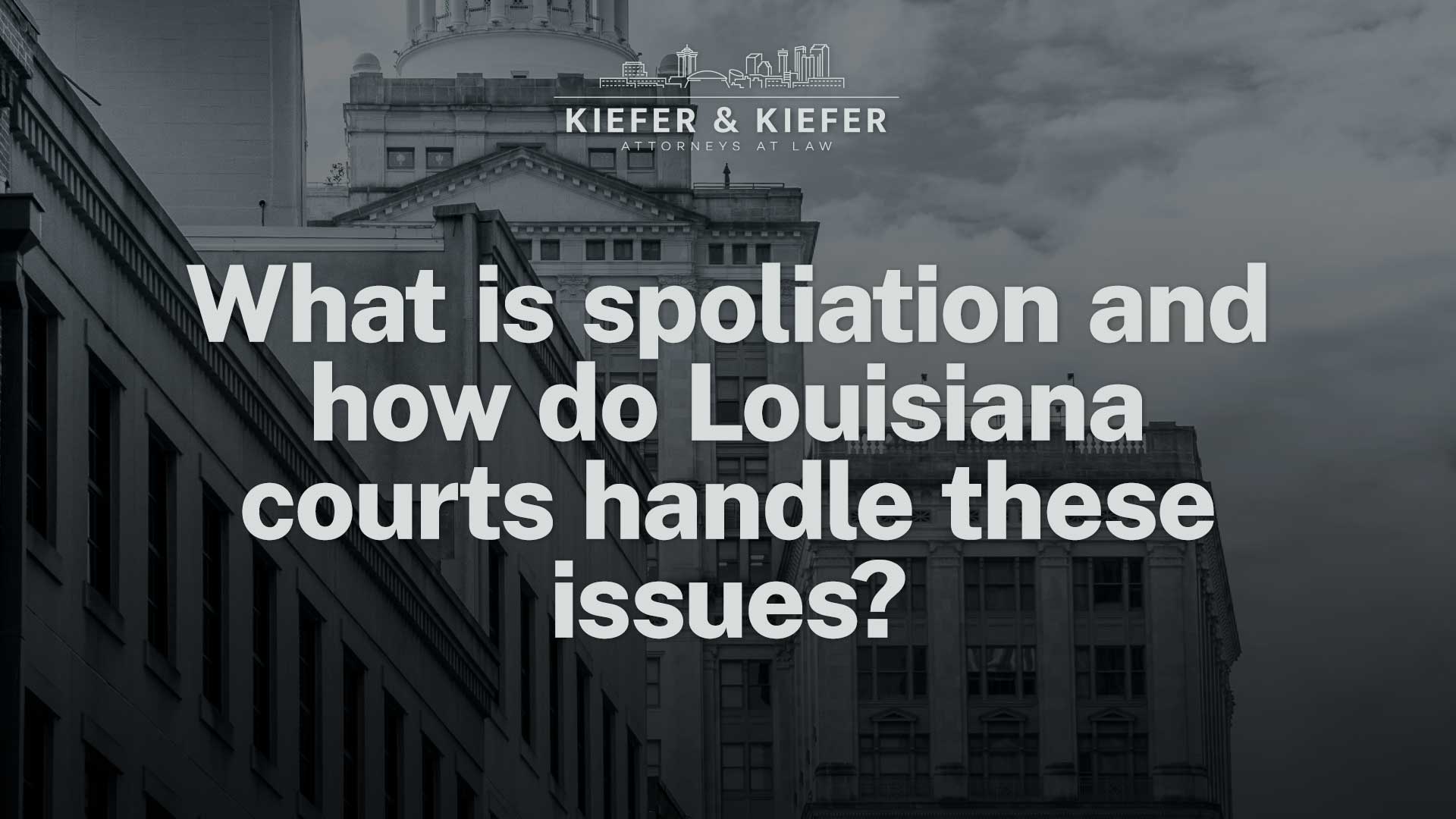The law of spoliation deals with what a court or jury should do where an important piece of evidence in a case has been destroyed and is no longer available to present to the trier of fact. In short, if you are in possession of evidence that may be important in a claim or lawsuit and you fail to preserve or destroy same, it may be presumed that the evidence was adverse to you even if it was not.
I. LOUISIANA SUPREME COURT’S RECENT DECISION
Louisiana Supreme Court’s most recent articulation regarding the law of spoliation established that no cause of action exists for negligent spoliation of evidence. Reynolds v. Bordelon, 2014- 2362 (La. 6/30/15), 172 So.3d 589. Although there is no tort, the Court noted that there are alternative recourse available in Louisiana’s evidentiary, discovery and contractual laws. The plaintiff in Reynolds sought a cause of action for the negligent spoliation of evidence against third-party spoliators who were the custodians of the subject vehicle following the accident and failed to preserve that vehicle for inspection purposes. Plaintiff sought a cause of action “where a specific duty arose due to an agreement, contract, special relationship, or undertaking which was formed between the parties specifically for the purpose of preserving the evidence.” Id. at 595. Although the lower courts have allowed such a tort, the Court declined to recognize the cause of action and “expressly refuse to recognize the existence of the tort.” Id. at 596.
In determining whether there was a tort for the negligent spoliation of evidence, the Court analyzed various policy considerations to determine whether there is a duty. Id. The first factor, deterrence of undesirable conduct, weighed in favor of no duty since “the act of negligently spoliating evidence is so unintentional an act that any recognition of the tort by the courts would not act to deter future conduct, but would, rather act to penalize a party who was not aware of its potential wrongdoing in the first place.” Id. The Court noted that this was particularly true in a case of negligent spoliation of a third party who is not vested in the case and has no motive to destroy the evidence. Two other factors, satisfaction of the community’s sense of justice and predictability, weigh against recognizing the tort of negligent spoliation since it would place a burden on society as a whole requiring third parties who are not aware of litigation to retain potential evidence in order to reduce their liability. Id. at 598. Allowing the tort would require all potential evidence to preserved for possible future litigation, which would restrict property rights by limiting one’s right to destroy their own property and would be costly to store the potential evidence, such as totaled vehicles. Id.
The last factor considered by the Court was the availability of other avenues of recourse. As to first party spoliators, there are discovery sanctions, criminal sanctions and Louisiana recognizes the adverse presumption against litigants who had access to evidence and did not make it available or destroyed it. Id. at 599. As to third parties, plaintiff who anticipates litigation can enter into an agreement to preserve the evidence or obtain a court order. Id.
II. STATUS OF THE LAW OF SPOLIATION IN THE FOURTH CIRCUIT
A. PRIOR TO THE SUPREME COURT’S REYNOLDS DECISION
The Fourth Circuit has consistently held that there must be intentional destruction of evidence in order to assert a spoliation claim or apply the adverse presumption rule. Williams v. Claiborne, 2008-0820 (La. App. 4 Cir. 1/28/09), 999 So. 2d 1262; Everhardt v. La. DOTD., 2007-0981 (La. App. 4 Cir. 2/20/08), 978 So.2d 1036, 1044; Quinn v. RISO Investments, Inc.,2003-0903 (La. App 4 Cir. 3/3/04), 869 So.2d 922, 926.
The requirement of intentional conduct for a spoliation claim was established by the Fourth Circuit in Quinn v. RISO Investments, Inc., when it expressly defined spoliation of evidence as “the intentional destruction of evidence for the purpose of depriving parties of its use.” Quinn, 869 So.2d at 926-27. Further holding that allegations of negligent misconduct are insufficient and a claimant must allege the destruction was intentional. Id. Accordingly, spoliation does not apply if no suit has been filed and there is no evidence that a party knew a suit would be filed when the evidence was discarded. Id. at 927. The court may either exclude the spoiled evidence or provide for an adverse presumption that the spoiled evidence was unfavorable to the spoliator. In order to find spoliation it must first be establish a duty to preserve the evidence and second that the evidence was destroyed with nefarious intent. Everhardt, 978 So.2d at 1036: A court may either exclude the spoiled evidence or allow the jury to infer that the party spoiled the evidence because the evidence was unfavorable to that party’s case. Lafayette Ins. Co. v. CMA Dishmachines, 2005 U.S. Dist. LEXIS 8026, 2005 WL 1038495, at *3 (U.S.D.C., E.D. La. 4/26/05). Before a court may exclude spoiled evidence or provide for an adverse inference to arise from the intentional destruction of evidence, “the party having control over the evidence must have had an obligation to preserve it at the time it was destroyed.”Kronisch v. U.S., 150 F.3d 112, 126 (2d Cir. 1998). Such a duty “arises when the party has notice that the evidence is relevant to the litigation.” Id. Once a court concludes that a party was obliged to preserve the evidence, it must then consider whether the evidence was intentionally destroyed and the likely contents of that evidence. See Id. at 127. See also Caparotta v. Entergy Corp., 168 F.3d 754, 756 (5th Cir. 1999)(adverse inference “predicated on bad conduct”); [Pg 8]Vodusek v. Bayliner Marine Corp., 71 F.3d 148, 156 (4th Cir. 1995)(requiring intentional and willful conduct); Anderson v. Production Management Corp., 2000 U.S. Dist. LEXIS 5696, 2000 WL 492095 at *3 (U.S.D.C., E.D. La. 4/25/00)(no adverse inference absent a showing of bad conduct).Furthermore, the presumption that evidence that a litigant fails to produce is detrimental to his case is not applicable when the failure to produce the evidence is adequately explained. Constans, supra at p.12, 712 So.2d at 902; Boh Brothers Constr. Co. v. Luber-Finer, Inc., 612 So.2d 270, 274 (La. App. 4 Cir. 1992).
The tort of spoliation has its roots in the evidentiary doctrine of “adverse presumption”, which allows a jury instruction for the presumption that the destroyed evidence contained information detrimental to the party who destroyed the evidence unless such destruction is adequately explained. Id.
B. FOURTH CIRCUIT FOLLOWING THE REYNOLDS DECISION
In decisions since Reynolds, the Fourth Court has cited the Supreme Court’s holding that Louisiana only recognizes a cause of action for intentional spoliation, which is in line with the circuit’s jurisprudence as established in Quinn. Fiveash v. Pat O’Brien’s Bar, Inc., 2015-1230 (La. App. 4 Cir. 9/14/16), 201 So.3d 912; Danna v. The Ritz-Carlton Hotel Co. LLC, 2015-0651 (La App. 4 Cir. 5/11/16), 213 So.3d 26; Tomilson v. Landmark Am. Ins. Co., 2015-0276 (La App. 4 Cir. 3/23/16), 192 So.3d 153. The remedy for spoliation is that the spoiled evidence is excluded or instruct the jury of the adverse presumption “had the evidence been produced, it would have been unfavorable to the litigant.” Danna, 213 So.3d 26 at 36-37; Tomilson, supra at 160.
Before any remedy for spoliation is imposed, Fourth Circuit jurisprudence requires proof that 1) the party having control of the evidence had a duty to preserve at the time it was destroyed and 2) whether the party intentionally destroyed the evidence. Tomilson, 192 So.3d at 160. However, if the destruction of the evidence is adequately explained, the adverse presumption does not apply. Danna, 213 So.3d 26 at 37.
1. DUTY TO PRESERVE
The first requirement for a spoliation claim is proof that the party having control over the evidence had a duty to preserve it at the time it was destroyed. The duty to preserve arises if the party has notice that the evidence is relevant to the litigation. Tomilson, 192 So. 3d at 160. If a suit has not been filed and there is no evidence the party knew a suit would be filed, then there is no duty to preserve. Quinn, 869 So.2d at 927. Unlike other circuits, the Fourth Circuit has not provided an opinion explaining at what point a duty to preserve is imposed prior to a suit being filed.
In Tomilson, the defendant knew about the slip and fall since plaintiff reported it the day of the incident. However, the surveillance videos were recorded over in the ordinary course of business before suit was filed. Although the court did not address whether defendant had a duty to preserve the video, it can be assumed defendant had a duty to preserve since the court focused on whether the destruction was intentional.
2. INTENTIONAL DESTRUCTION
Once a duty to preserve is established, the court must consider whether the party intentionally destroyed the evidence. The Fourth Circuit’s jurisprudence establishes that intent is an essential element of a spoliation claim, and “after Reynolds must be greater than the general negligence standard.” Tomilson, 192 So.3d at 153. A claim of spoliation must allege intentional destruction of evidence and allegations of negligent conduct are insufficient. Danna, 213 So.3d 26, 36. Further, “knowledge is an underlying material issue in the ultimate determination of intent.” Fiveash, surpa at 919.
In Tomilson, plaintiff asserted a claim for spoliation of evidence, alleging that defendant intentionally destroyed the surveillance video regarding her slip and fall which impaired her lawsuit. So.3d at 158. Plaintiff alleged defendant had a duty to preserve the video since she reported the incident to the store’s manager. Id. at 192. Defendant claimed the video was destroyed in the normal course of business and was not willful in nature. Id. at 158. The court agreed and found that although not clear as to how long defendant preserved videos before automatically recording over them, there was no evidence to suggest the video was intentionally destroyed for the purpose of depriving plaintiff of its use at trial. Id. at 160.
The dissent in Tomilson, pointed out that Reynolds involved a third party spoliator who was so attenuated from the underlying cause of action, which is different from a cause of action against a first-party spoliator. Nonetheless, the dissent still finds the framework set forth in Quinn applicable. Tomilson, 192 So.3d at 168.
In Fiveash v. Pat O’Brien’s Bar Inc., the plaintiff filed suit alleging injuries sustained when she fell on a step while exiting the bar. Subsequently, defendant notified plaintiff that the step was damaged by a garbage can and they intended to repair the step to the same condition it was at the time of the subject incident. 201 So.3d at 915. Plaintiff then amended her claim to include a spoliation of evidence claim, alleging defendant had a duty to maintain the condition of the step and pictures before and after show it was not repaired to the identical condition; thus, defendant intentionally destroyed the condition of the step which was motivated by the desire to deprive her of evidence to support her liability claim. Id. at 921. The court analyzed evidence of intent produced by both parties and remanded the case finding that whether defendant intentionally destroyed the evidence is a question for the trier of fact. Id. The dissenting opinion noted that to find spoliation, the law requires a showing of bad faith or bad conduct. Id. at 922, citing Yelton v. PHI, Inc., 284 F.R.D. 374 (E.D. La. 2012).
– Megan C. Kiefer is a partner and trial attorney at Kiefer & Kiefer, who specializes in accident and injury litigation. She has tried cases involving issues of spoliation and missing evidence.
This is being provided for informational purposes only and not for the purpose of providing legal advice.



